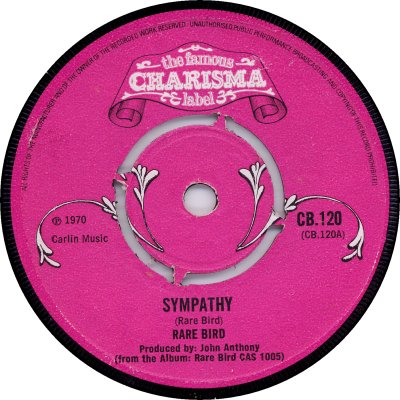
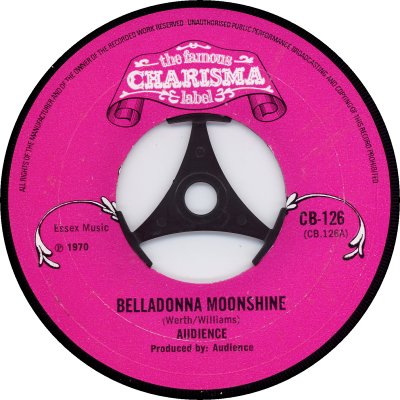
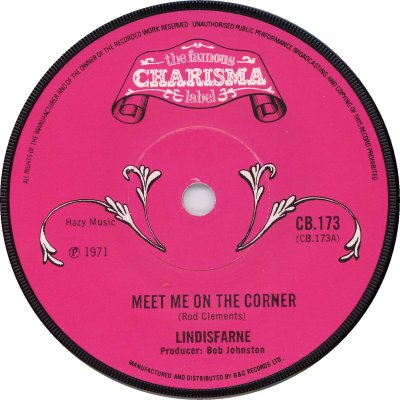
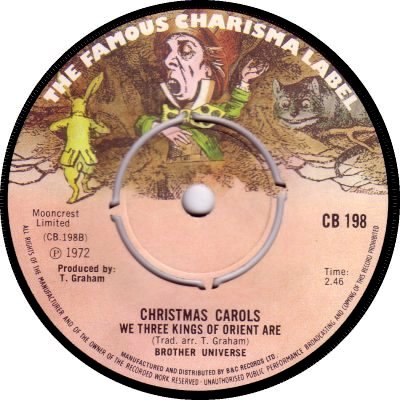
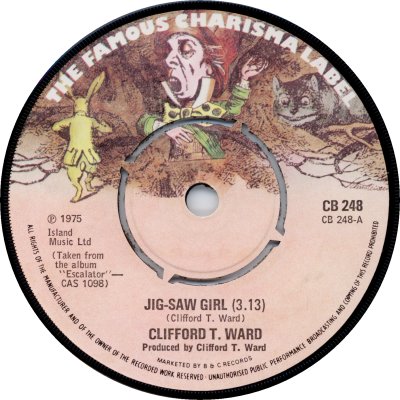
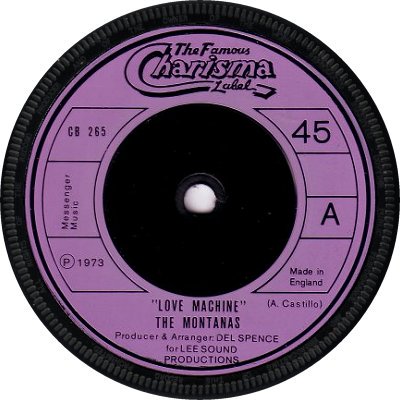
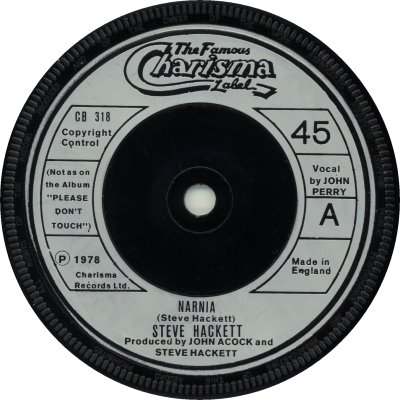
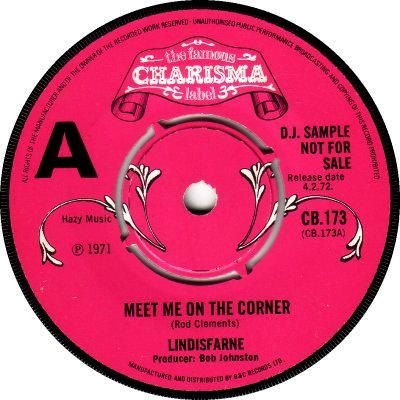
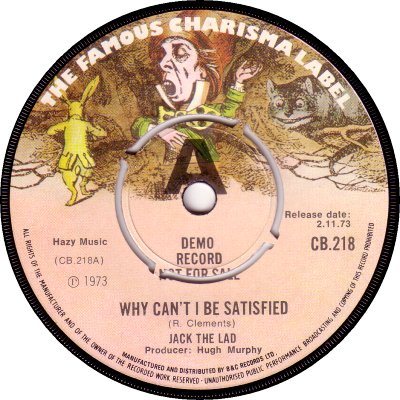
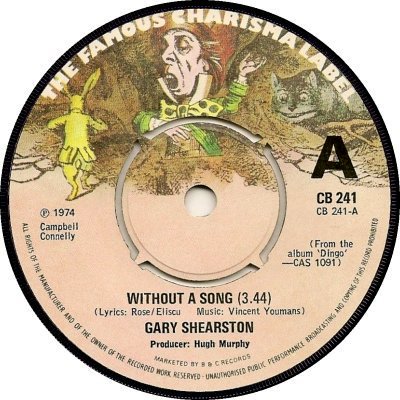
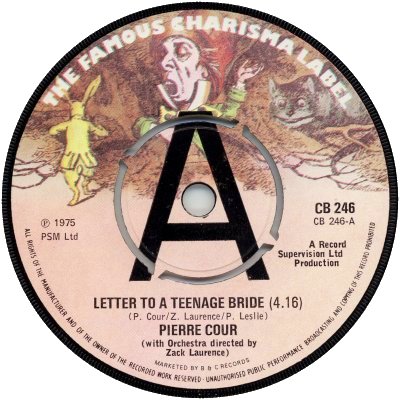
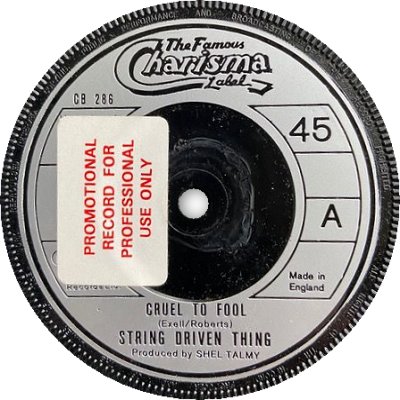
A respected independent label with an eclectic stable of artists, Charisma - 'The Famous Charisma Label' as its labels proclaimed boldly from the beginning - was started in October 1969 by journalist Tony Stratton-Smith, at the suggestion of B&C boss Lee Gopthal, supposedly after a conversation in a pub. It enjoyed a close relationship with B&C (q.v.), which was responsible for marketing and distributing it (via Island and Philips) initially - the relationship included the two companies' singles sharing a CB-100 numerical series. Charisma's first mention in 'Record Retailer' came in the issue of the 2nd of November 1969, which said that the label's first release - a self-titled album by Rare Bird - was due out on the 15th. That album yielded an unlikely hit single in the form of 'Sympathy' b/w 'Devil's High Concern' (CB-120; 2/70), which must have come as a pleasant surprise to the management. In the early period Charisma's stable of artists consisted mainly of 'progressive-leaning' bands such as Audience, Van Der Graaf Generator, The Nice, Rare Bird themselves and, most notably, Genesis, all of whom were more at home with albums than singles, so it is hardly surprising that the company had to wait until early 1972 for its second Chart hit, Lindisfarne's Folk-flavoured 'Meet Me On The Corner' b/w 'Scotch Mist' and 'No Time To Lose' (CB-173; 2/72). By that time there had been talks with Philips about that company taking a one-third share in Charisma but no agreement had been reached, Charisma preferring to remain independent. At that time Philips was handling the label worldwide except for the UK ('Billboard', 2nd October 1971). Charisma did however exchange minority holdings of shares with B&C not long after the talks with Philips ended, in order to forge stronger links between the companies ('RR', 13th November 1971).
In the summer of 1972 the distribution agreement between B&C, Charisma and Island was ended by mutual agreement. 'RR' of the 1st of July reported that both labels would be distributed exclusively by EMI from the 1st of July, and added that there was a possibility of the two companies amalgamating. 'Billboard' of the 29th of July said that no details of the proposed merger had yet been made public but that B&C's publishing companies Trojan Music and B&C Music had been merged, as had Charisma's counterparts Brewer Music and Mooncrest. In the event the proposed amalgamation of B&C and Charisma never took place. There was one minor development later that year: 'RR' of the 23rd of September 1972 reported that there was to be a change in Charisma's label design, the original 'scroll' label (1, 2, 3) being replaced by a 'Mad Hatter' one (4). Legend has it that the design of the 'scroll' label was influenced by the scrollwork and lettering on one of the mirrors at the pub where the meeting between Gopthal and Stratton-Smith took place. Around that time B&C stopped releasing records itself and concentrated on marketing, which left Charisma's singles in sole possession of the CB-100 catalogue numbers.
Charisma's main interest continued to be the album market, but it made the occasional appearance in the Singles Chart. Lindisfarne got to the No.3 spot with the reissued 'Lady Eleanor' b/w 'Nothing But The Marvellous Is Beautiful' (CB-153; 1972) but failed to crack the Top 30 with 'All Fall Down' b/w 'We Can Swing Together' (CB-191; 9/72); Clifford T. Ward's 'Gaye' b/w 'Home Thoughts From Abroad' (CB-205; 4/73) peaked at No.8, but his 'Scullery' b/w 'To An Air Hostess' (CB-221; 11/73) stalled at No.37; Genesis supplied an isolated hit with 'I Know What I Like' b/w 'Twilight Alehouse' (CB-224; 1/74), which only just failed to enter the Top 20; and Gary Shearston enjoyed a surprise hit with his rendering of 'I Get A Kick Out Of You' b/w 'Witnessing' (CB-234; 9/74); but it was only in early 1977, when Genesis hit their commercial stride, that the label began to appear frequently in the Charts.
The summer of 1975 saw the end of the original B&C company: parts of it were bought by Saga, the remainder went into liquidation. Happily Charisma wasn't badly affected by its partner's financial troubles. 'Music Week' of the 14th of June 1975 reported that B&C's new owners had retained the right to press Charisma product until the 31st of August, but this seems not to have been followed through; the same issue stated that Charisma had signed a replacement pressing and distribution deal with Phonogram. A company spokesman was quoted as saying that Charisma 'could not afford to continue with a licensing deal, though B&C did a fine job', which indicates that the agreement between the two companies was a licensing one at that time. Charisma did suffer some fallout from the B&C debacle: 'MW' of the 20th of December 1975 quoted managing director Frank Sansom as saying that because B&C had gone down a lot of people had thought that Charisma had gone with it. According to Sansom B&C had been an umbrella for several different companies, not one big conglomerate, and Charisma's identity had been very different to that of the other firms involved.
As mentioned in that article, after the move to Phonogram Charisma's emphasis turned towards singles; nevertheless, Stratton-Smith's eye for quirky material remained open. The artist roster broadened in scope, and before the end of the decade it had included the unlikely figures of Charlie Drake, Dame Edna Everage and Sir John Betjeman alongside Monty Python. Pop music began to feature, and the company dipped its toes into the Disco and Reggae fields, with Heads Together for the former and G. T. Moore & The Reggae Guitars and R. D. ('Dandy') Livingstone for the latter. Chart success remained sporadic, however: Chris White got into the Top 40 with 'Spanish Wine' b/w 'She's Only Dancing' (CB-272; 1/76); Peter Gabriel took 'Solsbury Hill' b/w 'Moribund The Burgermeister (CB-301; 3/77) to the No.13 position; and Bill Lovelady managed one place higher than that with 'Reggae For It Now' b/w 'Reggae For Strings' (CB-337; 7/79), but the company only found a regular Chart act when Genesis began their run of hits, in 1977. Charisma retained its own particular flavour and its independence into the '80s, but it was bought by Virgin in 1985 and continued as a part of that company.
Three basic label designs were used in the '70s. The 'scroll' design lasted until September 1972, CB-192 being the last single to bear it; later pressings of that record have the replacement 'Mad Hatter' labels. The 'Mad Hatter' design remained basically unchanged until the move to Phonogram, in June 1975, though the legend 'Manufactured and distributed by B&C Records Ltd' at the bottom of the label was replaced by 'Marketed by B&C Records' from CB-238 onwards (5). Charisma spent the remainder of the decade with Phonodisc, and its singles were given a new logo - presumably the 'Mad Hatter' design was too complicated for Phonogram's injection moulding process to handle. At first the injection moulded labels were purple (6); the colour changed to silver with CB-295 in September 1976 (7). Other colours, including fawn and metallic blue, made an occasional appearance.
Demo markings seem not to have come into widespread use on the 'scroll' labels until the start of 1972. The markings consisted of a small black 'A' and the legend 'D.J. sample not for sale' (8). 'Mad Hatter' labels had the standard EMI demo markings (9) until June 1976 and CB-231. After that the 'Demo Record Not For Sale' text disappeared, leaving the small black 'A' on its own (10). From February 1975, with CB-246, a big black central 'A' was used (11), though for some reason CB-248 had the old-style small 'A'. Demos of injection moulded singles were infrequent and had the appropriate wording; a few were given 'Promotional Record' stickers (12) - thanks to John Timmis for that scan. During much of the 'Mad Hatter' period demos were specially pressed and had the same track on both sides, a practice followed by some of other labels in the B&C / Charisma group such as Mooncrest, People and Cloud One (q.v. all) but not elsewhere in Britain - it was common for American companies to do that, but they tended to put a stereo version on one side and a mono on the other. When the big central 'A' was introduced the special pressings were discontinued; big 'A' demos are just standard issues overprinted, and thus have the same 'B' side as the issues.
Turning to the subjects of manufacture and distribution, 'Scrolls' up to and including CB-126 appear to have been either Orlake or Philips pressings, which resulted in either roughish label surfaces (1), three-pronged dinking perforations or large spindle holes (2), the latter two being found on Philips products. Island, which handled B&C and Charisma records at first, turned to EMI for manufacture in the autumn of 1970, and Charisma's singles took on EMI's 'solid centre' (3) or 'four narrow perforations' (4) appearance. As stated above, Charisma turned to Phonodisc for manufacture and distribution in June 1975 - Phonodisc had been handling the label in many other countries since August 1972, so the step was a natural one. The discography below only covers the 1970s; many of the missing numbers are B&C releases .



Copyright 2006 Robert Lyons.

